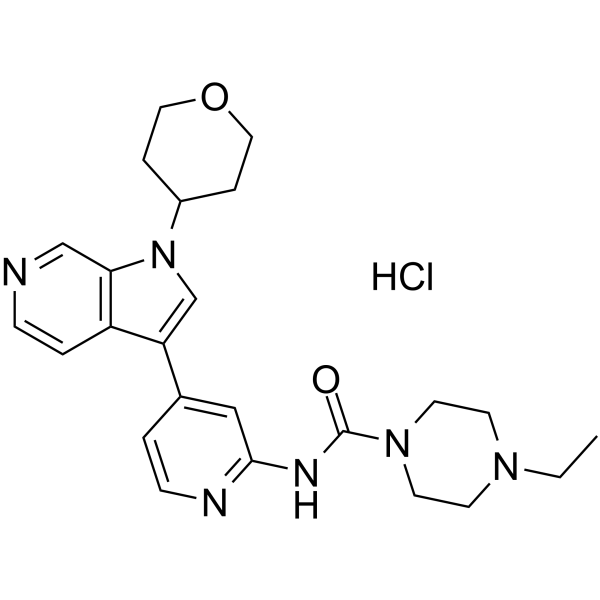GNF2133 hydrochloride
Modify Date: 2024-01-08 09:01:19

GNF2133 hydrochloride structure
|
Common Name | GNF2133 hydrochloride | ||
|---|---|---|---|---|
| CAS Number | 2561414-57-9 | Molecular Weight | 470.99 | |
| Density | N/A | Boiling Point | N/A | |
| Molecular Formula | C24H31ClN6O2 | Melting Point | N/A | |
| MSDS | N/A | Flash Point | N/A | |
Use of GNF2133 hydrochlorideGNF2133 hydrochloride is a potent, selective and orally active DYRK1A inhibitor with IC50s of 0.0062, >50 µM for DYRK1A and GSK3β, respectively. GNF2133 hydrochloride shows good proliferation potency and efficacy on rat and human primary β-cell. GNF2133 hydrochloride significantly improves glucose disposal capacity and increases insulin secretion. GNF2133 hydrochloride has the potential for the research of type 1 diabetes[1]. |
| Name | GNF2133 hydrochloride |
|---|
| Description | GNF2133 hydrochloride is a potent, selective and orally active DYRK1A inhibitor with IC50s of 0.0062, >50 µM for DYRK1A and GSK3β, respectively. GNF2133 hydrochloride shows good proliferation potency and efficacy on rat and human primary β-cell. GNF2133 hydrochloride significantly improves glucose disposal capacity and increases insulin secretion. GNF2133 hydrochloride has the potential for the research of type 1 diabetes[1]. |
|---|---|
| Related Catalog | |
| Target |
DYRK1A:0.0062 μM (IC50) GSK3β:>50 μM (IC50) |
| In Vivo | GNF2133 hydrochloride (30 mg/kg; p.o.) shows good oral absorption with oral bioavailability of 22.3%[1]. GNF2133 hydrochloride (30 mg/kg; p.o.; once a day for 5 days) shows the ability to proliferate β-cells in vivo[1]. GNF2133 hydrochloride (3, 10, 30 mg/kg) significantly improves glucose disposal capacity and increased insulin secretion in RIP-DTA mice[1]. Pharmacokinetic Parameters of GNF2133 hydrochloride in CD-1 mice[1]. plasma (iv) plasma (po) pancreas (po) CL (mL/min/kg) 23.5 Vss (L/kg) 11 AUC (h·nM) 3268 10974 144420 Cmax(nM) 1977 1675 13319 tmax<(h) 0.03 3.0 3.0 Clast(nM) 36.6 19 1324 t1/2<(h) 6.6 3.4 6.6 F (%) 22.3 CD-1 mice; 30 mg/kg; p.o.sup>[1]. Animal Model: CD-1 mice[1] Dosage: 30 mg/kg Administration: P.o. Result: Showed good oral absorption and moderate plasma exposure with oral bioavailability of 22.3%. Animal Model: Wistar Han rat[1] Dosage: 30 mg/kg (0.5% methylcellulose + Tween-80) Administration: P.o.; once a day for 5 days Result: Increased cyclin D1 levels and overall cell density, and increased in cell proliferation marker Ki67 and insulin. Animal Model: Diphtheria toxin A (RIP-DTA) mice[1] Dosage: 3, 10, 30 mg/kg (20 mg/kg doxycycline (Dox) for 5 days) Administration: P.o., once a day for 35 days Result: Significantly improves glucose disposal capacity and increased insulin secretion. |
| References |
| Molecular Formula | C24H31ClN6O2 |
|---|---|
| Molecular Weight | 470.99 |